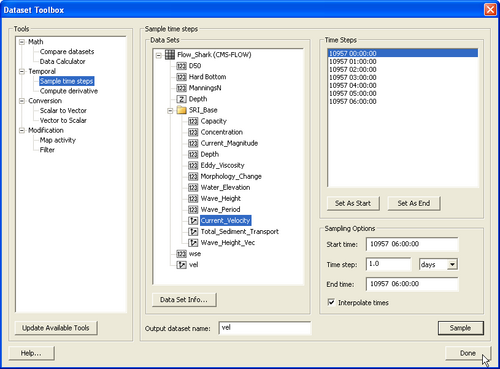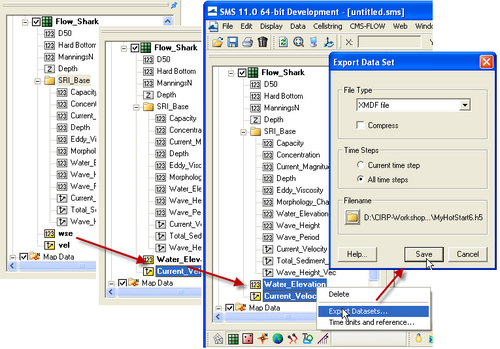CMS-Flow:Features
Surface Roller
Table 1. CMS-Flow cards related to the surface roller
| Card | Arguments | Range | Default | Description |
|---|---|---|---|---|
| CALC_ROLLER | CHARACTER | ON | OFF | OFF | Turns on or off the surface roller model in CMS. |
| ROLLER_DISSIPATION_COEFFICIENT | REA | 0.1 | 0.05-0.15 | Roller dissipation coefficient. |
| ROLLER_EFFICIENCY_COEFFICIENT | REAL | 1.0 | 0.5-1.0 | Roller efficiency coefficient. |
| ROLLER_SCHEME | CHARACTER | UPWIND1 | UPWIND2 | LAX | UPWIND1 | Determines the numerical scheme used for the surface roller calculation. UPWIND1 is a first order upwind scheme, UPWIND2 is a second order upwind scheme, and LAX is the second order Lax scheme. |
Hot Start
The term Hot start refers to starting a simulation with an initial condition other zero (cold start). Hot starts are used for specifying initial conditions or restarting simulations at intermediate times. The hot start controls are set in the Flow tab of the CMS-Flow Model Control window.
Hot Start File
The CMS hot start feature CMS lets the user restart simulations that have been stopped due to electric outages, hardware malfunctions, or model crashes. In the case of a model crash the user, may restart the model using larger solver iterations and/or time steps to stabilize the simulation. The user has the option to specify a hot start output time or an interval for outputting a recurring hot start file. Every time the hot start file is written, it overwrites the previous information. The CMS Hot Start file saves information on the water elevation (pressure), and current velocities. If the sediment transport is active, then the water depth, and sediment concentrations are also saved for each size class. The CMS hot start file is a binary XMDF file, has the name Hot_Start.h5 and is saved in the directory of the CMS-Flow files. Figure 1 shows the structure of the hot start file. After saving a CMS Hot Start file, it is a good idea to rename the file with a different name before using it as an initial conditions file. This way, the file will not be overwritten in future simulations.
Table 1. Hot Start CMS-Flow Cards
| Card | Arguments | Default | Range | Description |
|---|---|---|---|---|
| HOT_START_OUTPUT_FILE | CHARACTER | none | none | Julian hour. |
| HOT_START_TIME | REAL | none | none | Sets the hot start output time. |
| AUTO_HOT_START_INTERVAL | REAL | none | none | Sets the recurring hot start output time. |
Initial Conditions File
There are several situations where it is convenient to specify a user defined hot start file. For example, if the user forgets to setup the model output a hot start file or when running steady state conditions. A hot start file can easily be created and exported by the user from the SMS interface. The model requires at water levels, current velocities, concentrations, and water depths. Any datasets that are missing from the initial file. It is important to note that the names and paths of the initial condition datasets is important.
Table 2. Path and name for initial condition file variables.
| Variable | Path and Name |
|---|---|
| Water surface elevation | Datasets\Water_Elevation |
| Current velocity | Datasets\Current_Velocity |
| Sediment concentrations | Datasets\Concentration |
| Salinity concentrations | Datasets\Salinity |
The steps for creating a user defined hot start or initial condition file from a CMS-Flow solution file are outlined below.
- Import CMS-Flow grid and solution file.
- Sample a time step of the solution datasets for use in the initial condition
- Click on Data | Data Calculator
- Under the Tools section, select Sample time steps.
- Under the Datasets section, click on the Water Elevation
- Click on Data | Data Calculator
- Export the initial condition datasets to an XMDF file
Table 3. CMS-Flow card for specifying the initial condition file.
| Card | Arguments | Default | Range | Description |
|---|---|---|---|---|
| INITIAL_STARTUP_FILE | CHARACTER | none | none | Julian data in YYDDD with YY being last two digits of the year, and DDD the Julian day of the year. |
Parallelization with OpenMP
Both Intel and AMD processors now are shipping chips with multiple cores/processors (henceforth referred to as "processors") available. CMS-Flow is now configured to make use of these extra processes that are available on newer machines.
Additional information on using Multiple Processors with CMS-Flow can be found here.
Output
The following advanced cards have been added to CMS v4.0 and higher for outputting additional output information, ASCII file output, and more.
| Card | Arguments | Description | Default value |
|---|---|---|---|
| XMDF_COMPRESSION | ON | OFF | Compresses the h5 file by a factor of about 7 | OFF |
| WAVE_OUT_TIMES_LIST | integer | Output time series id | 0 |
| EDDY_OUT_TIMES_LIST | integer | Output time series id | 0 |
| VISC_OUT_TIMES_LIST | integer | Output time series id | 0 |
| STRESS_OUT_TIMES_LIST | integer | Output time series id | 0 |
| BED_SHEAR_STRESS_OUT_TIMES_LIST | integer | Output time series id | 0 |
| GLOBAL_TECPLOT_FILES | ON | OFF | Outputs Tecplot ASCII files | OFF |
| GLOBAL_SUPER_FILES | ON | OFF | Outputs Tecplot ASCII files | OFF |
| GLOBAL_STATISTICS | [t0] [tn] [dt] | Calculates global statistics if specified | none |
| FLOW_STATISTICS | [t0] [tn] [dt] | Calculates flow statistics if specified | none |
| SEDIMENT_STATISTICS | [t0] [tn] [dt] | Calculates sediment statistics if specified | none |
| SALINITY_STATISTICS | [t0] [tn] [dt] | Calculates salinity statistics if specified | none |
Numerical Methods
The four different solvers implemented in the implicit model are the Gauss-Seidel, Gauss-Seidel with Successive-Over-Relaxation, BICGSTAB, and GMRES. The same solver is applied to flow, sediment and salinity. The default solver is the GMRES. The solver may be changed using the advanced card in the table below.
| Card | Arguments | Description | Default value |
|---|---|---|---|
| SOLVER_TYPE | GAUSS-SEIDEL | GAUSS-SEIDEL-SOR | BICGSTAB | GMRES | Determines the numerical solver used | GMRES |
| HYDRO_MAX_ITER | integer | Maximum number of iterations (outer loop) for the hydrodynamics | 20 |
| SEDIMENT_MAX_ITER | integer | Maximum number of iterations (outer loop) for the sediment transport | 20 |
| SALINITY_MAX_ITER | integer | Maximum number of iterations (outer loop) for the salinity transport | 20 |
Advection scheme
As in the case of the solver, the same advection scheme is applied for the flow, sediment and salinity transport equations. There are three choices for advection schemes with upwinding in the implicit model: hybrid, exponential and HLPA. The hybrid scheme is fast but is the most diffusive. The exponential scheme is based on the 1D analytical solution to an advection-diffusion equation and produces very stable results. The HLPA is very stable and non-diffusive, but requires slightly more computational time. For most applications, the exponential scheme is recommended and is set as the default. The advection scheme may be change using the advanced card
| Card | Arguments | Description | Default value |
|---|---|---|---|
| ADVECTION_SCHEME | HYBRID | EXPONENTIAL | HLPA | Determines the advection scheme | EXPONENTIAL |
Units of Measurement
| Variable | Units | Symbol |
|---|---|---|
| Water Surface Elevation | meters | |
| Current Velocity | meters per second | |
| Flow Rate | cubic meters per second | |
| Salinity Concentration | parts per thousand | |
| Sediment Concentration | kilogram per meter cubed | |
| Sediment Transport | meter squared per second | |
| Bed Shear Stress | kilogram per meter per second squared |










